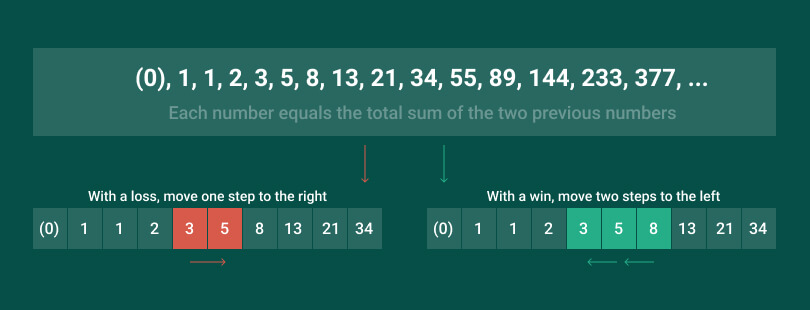How Does the Fibonacci Roulette Strategy Work?
The Fibonacci sequence grows exponentially with each following number. This is in line with other popular betting strategies, like the Martingale, in which there’s a positive progression after each losing spin. Normally, the progression would start with 0, but since we use the sequence as a betting progression, we can disregard the 0 and start with 1. This is what the sequence for betting would look like.
0, 1, 1, 2, 3, 5, 8, 13, 21, 34, 55, and so on.
Note that this system can only be used on bets that return almost even-money, like Red/Black, Odds/Evens, and High/Lows. These are all bets with a payout ratio of 1:1. For simplicity, we’ll use a unit size of 1 unit = CA$1.

We start by placing a CA$1 bet on any even-money that we want. Let’s say that we lost the first bet. For the next bet, we turn to the number that’s coming to the right on the sequence - which is 1 again. We bet CA$1 again, and let’s say that we lose again. Now, the next number is 2, so we bet CA$2. Let’s say that we lose again, and so on, until we win.
But what happens when we win a bet? We just shift two spots to the left on the sequence. So, if, for example, we placed a CA$13 bet and we won, we need to shift two spots to the left. That means that for our next bet, we would have to bet CA$5. If we win again, we will go back to CA$2, and so on.
Let’s see how the Fibonacci roulette strategy works with several provisional spins.
- Spin 1
We wager CA$1 on Red. The ball lands on Red. We win.
- Spin 2
In the second spin, we wager CA$1 on Red again. We lose this time.
- Spin 3
We now follow the sequence and wager CA$2 on Red. The ball lands on Black, and we lose again.
- Spin 4
We follow the sequence again and wager CA$3 on Red. We lose again.
- Spin 5
We follow the sequence and wager CA$5 on Red. The ball lands on Black, so we lose, and we move one spot to the right on the sequence.
- Spin 6
We wager CA$8 on Red. This time, we win. We go to two spots to the left in the sequence.
- Spin 7
We now wager CA$3 on Red. We win again. We move two spots to the left, which is the beginning.
- Spin 8
We wager CA$1 again, and we’re back at the start. If we win, we move to the right, and if we lose, we move two spots to the left.
Putting the Fibonacci Roulette System to the Test
To test how the Fibonacci strategy for roulette works in a real-life scenario, we decided to test it in a simulation. We generated a Google Sheets roulette simulation for 500 spins, with the loss probability set at 52.40% and the win probability set at 48.60%, mimicking European roulette. We kept the house advantage at 2.70%, just like in European roulette.
We decided to run the test with 3 hypothetical players, with each one of them starting with a bankroll of CA$1,000. Each one of them followed the Fibonacci strategy, and we monitored the bankroll during the 500 spins. Check out the graph for Player 1 to see how they performed.

Player 1 started with a bankroll of CA$1,000, and the maximum amount they had to wager on a single bet was CA$89. The lowest the bankroll fell at one point was CA$877, and the player finished the session with CA$1,074, with a total profit of CA$74.
Check out how Player 2 did.

Player 2 also ended the 500 spins in profit. Their total bankroll in the end was CA$1,124, which means they netted CA$124 in profit.
This is how Player 3 did:

Player 3 was also lucky as they didn’t experience any major hiccups. They finished the session with a total bankroll of CA$1,139, which means they made CA$139 in profit.
As we can see from our Fibonacci roulette strategy test, all three players made a profit with the strategy. None of them experienced any long sessions, and there were never any major risks. Theoretically, the strategy can drain your bankroll if you experience several consecutive losses, but that didn’t happen in our test.
For such a thing to happen, it would take 14 consecutive losses (with a starting bankroll of CA$1,000). By the 14th spin, the bet size would be CA$377. The chances of this happening are 0.524^14 or 0.000117.
Where Does the Fibonacci Betting Strategy Come Short
This is a progression system, which means that there’s always the risk of losing your bankroll quickly if you lose many times in a row. However, as we saw from our tests, that’s not necessarily the case with this strategy. The progression is slow, and if you have a large enough starting bankroll, you shouldn’t experience major problems. The possibility of draining your bankroll is very low at 0.524^14. As long as you keep the starting unit low (for example, CA$1), your bankroll should last you throughout your session.
This is a system with minimal risk, and the largest potential drawback is its speed. It’s a very slow system, so it will take you a lot of time to make some substantial gains and achieve your goal target.
Conclusion
The Fibonacci roulette strategy is popular for a reason. It’s simple enough that you can execute it very easily, and yet it promises good results. As we saw from our test, all three of our players made some good progress in their simulations, and all of them completed the 500 spins in a profit.
Due to how the algorithm works, the wager will never be too high. For example, the largest bet we saw in our simulations was when Player 1 had to wager CA$89 at one point. They still finished the session in profit.
Another positive of this system is the progression itself. After each loss, we have to move one step to the right, and when we win, we go back two steps. This means that the bet size won’t be too large even in long sessions, and it’s very unlikely to reach the table limits or drain your bankroll.
Note, however, that you should still mind the table limits when choosing a table. You should choose a table based on your initial bankroll and check the maximum bet allowed on the table. As for the bankroll, we suggest at least CA$100. This bankroll can, in theory, be enough for 8 consecutive losses. However, in reality, starting with a higher bankroll would be much better.
Fibonacci had no clue that his sequence would become a popular betting strategy for roulette, but this system is one of the most popular out there, and if you stick to the progression and set a realistic goal, the Fibonacci strategy can be considered a safe one - and less risky than the Martingale strategy, which is the most popular one.
















